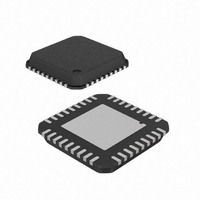AT88RF1354-ZU Atmel, AT88RF1354-ZU Datasheet - Page 38

AT88RF1354-ZU
Manufacturer Part Number
AT88RF1354-ZU
Description
IC RF READER 13.56MHZ 36-VQFN
Manufacturer
Atmel
Datasheet
1.AT88RF1354-ZU.pdf
(48 pages)
Specifications of AT88RF1354-ZU
Frequency
13.56MHz
Features
ISO14443-B
Package / Case
36-VQFN Exposed Pad, 36-HVQFN, 36-SQFN, 36-DHVQFN
Pin Count
36
Screening Level
Industrial
Lead Free Status / RoHS Status
Lead free / RoHS Compliant
Rf Type
-
Lead Free Status / Rohs Status
Compliant
D.4.4. Stencil Thickness and Solder Paste
D.4.5. Solder Joint Standoff Height and Fillet Formation
38
A stencil thickness of 0.125 mm is recommended for 0.4 and 0.5 mm pitch parts. A laser-cut, stainless steel stencil is
recommended with electro-polished trapezoidal walls to improve the paste release. Since not enough space is
available underneath the part after reflow, it is recommended that the “No Clean”, Type 3 paste be used for mounting
QFN packages. Nitrogen purge is also recommended during the reflow.
The solder joint standoff is a direct function of the amount of paste coverage on the thermal pad and the type of vias
used for QFNs with the exposed pad at the bottom. Board mounting studies sponsored by Amkor ® have clearly
shown that the package standoff increases by increasing the paste coverage and by using plugged vias in the thermal
pad region. This is shown in Figure D-6. below.
The standoff height varies by the amount of solder that wets or flows into the PTH via. The encroached via provides an
easy path for solder to flow into the PTH and decreases the package standoff height while the plugged via impedes the
flow of solder into the via due to the plugged via's closed barrel end. In addition, the number of vias and their finished
hole size will also influence the standoff height for encroached via design. The standoff height is also affected by the
paste type, the reactivity of the solder paste used during assembly, the PCB thickness, the copper thickness, the
surface finish, and the reflow profile.
To achieve 50 micron thick solder joints, which help in improving the board level reliability, it is recommended that that
the solder paste coverage be at least 50% for the plugged vias and 75% for the encroached via types.
The peripheral solder joint fillets formation is also driven by multiple factors. It should be realized that only the bottom
surface of the leads are plated with solder and not the ends. The bare Cu on the side of the leads may oxidize if the
packages are stored in an uncontrolled environment. It is, however, possible that a solder fillet will be formed
depending on the solder paste (flux) used and the level of oxidation.
Figure D-6. Standoff height as a function of via type and paste coverage.
13.56 MHz Type B RF Reader Specification
3.25
2.75
2.25
1.75
1.25
0.75
0.25
2.5
1.5
0.5
3
2
1
0
COVERAGE
VIA @ 37%
PLUGGED
PASTE
48 IO
Standoff Height as a function of Via Type & Center Pad Solder Paste Coverage
VIA @67%
PLUGGED
Coverage
PASTE
48 IO
ENCROACH
VIA @ 37%
Coverage
PASTE
48 IO
ENCROACH
VIA @67 %
Coverage
48 IO
Paste
VIA @ 50%
PLUGGED
Coverage
PASTE
68 IO
VIA @ 81%
PLUGGED
Coverage
PASTE
68 IO
ENCROACH
VIA @ 50%
Coverage
PASTE
68 IO
ENCROACH
VIA @ 81%
Coverage
PASTE
68 IO
8547B–RFID–3/09
Standoff
Height
(mils)












